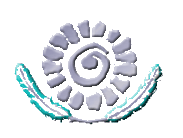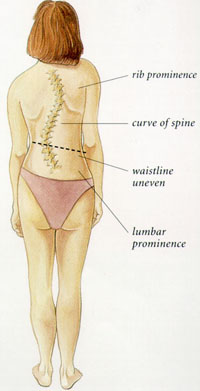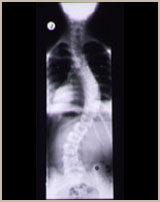 |
||||||||||||||||||||||||
|
|
||||||||||||||||||||||||
 |
||||||||||||||||||||||||
 |
||||||||||||||||||||||||
|
||||||||||||||||||||||||
 |
 |
|||||
 |
||||||
 |
||||||
|
The spine has natural curves that round the shoulders and make the lower back curve slightly inward. However, some people also have spines that curve side to side. This condition of side-to-side spinal curves is called scoliosis. More than six million people suffer from some type of scoliosis. Approximately 1 million of those will undergo surgery for this condition. An x-ray of a spine with scoliosis looks more like a "C" or an "S" than a straight line. Scoliotic spines may also have some bones that have rotated slightly that make the person's waist or shoulders appear uneven. The deformity of the spine occurs in varying degrees in all three planes: back-front; side-to-side; and top-to-bottom. Congenital spinal column abnormalities, neurological disorders, and genetic conditions are known to cause spinal deformity. Congenital scoliosis is caused by abnormal vertebral formation. Kidney abnormalities are often associated with congenital scoliosis. Surgery is usually the only treatment considered for congenital scoliosis. Neuromuscular disease may cause spinal deformity, especially in those patients who do not walk because of the underlying disease. Bracing has no long-term effect on the progression of the condition in the majority of these cases. Therefore, surgical correction and stabilization are done to prevent curve progression. Many times, a specific cause for scoliosis cannot be found. This is considered idiopathic scoliosis. It is broken down into three age groups: Infantile – from birth to three years, juvenile – from three to nine years, and adolescent from 10 to 18 years. Sometimes, these forms of scoliosis will resolve without intervention. Surgery is usually performed on infantile and juvenile scoliosis if curve progression is present. It may affect ultimate adult height, but the medical community considers it worth the risk. The most common form of scoliosis is idiopathic adolescent. It affects boys and girls equally. However, eight times as many girls suffer from curve progression that needs some form of intervention. Brace management is the preferred method of treatment if there is still significant growth development time left. Surgery is recommended when adult height has been reached and curves are progressing. Curve progression is associated with degenerative intervertebral disc disease and degenerative joint disease in middle-aged and older patients when their scoliosis has been left untreated. Severe curves may affect pulmonary and cardiac function later in life if the scoliosis has been left untreated. Some scoliosis patients feel pain from the scoliosis, but not all. Some patients have pain resulting from the corrective surgery. Still others experience pain from the organs, muscles, tendons, fascia, and bones in other areas of the body that are being stressed by the misaligned spine. Common conditions that may result from scoliosis are rib deformity, shortness of breath, chronic fatigue, back, neck, leg, hip or knee pain, TMJ, headaches, digestive problems, mood swings and menstrual disturbances, to name just a few. Myofascial release therapy and the integrative approach taken by Windsong Therapy and Wellness may be very useful in dealing with the pain, fatigue, digestive and other difficulties the body may be experiencing. The medical community does not feel manual therapy to be of benefit for scoliosis. However, the approach used by Windsong Therapy and Wellness to treat our scoliosis patients has resulted in reports of reduced pain and improved posture and function. |
| [Home] |
|
This website last updated on 31 July 2010 This website is entirely funded by Windsong Therapy and Wellness, Inc. |
|
Disclaimer: Confidentiality of data relating to individual patients and visitors, including their identity, is respected by this Web site. The owners of this Web site undertake to honor or exceed the legal requirements of medical / health information privacy that apply in Texas and the United States. The information on this Web site is Copyright © 1999-2008 Windsong Therapy and Wellness, Inc. Please obtain permission from Windsong Therapy and Wellness, Inc. before reproducing any information from this Web site. |